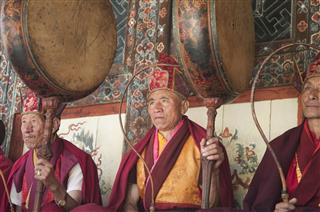
Buddhism is a profoundly encompassing religion and there are many Buddhist scriptures and monasteries. In these scriptures and monasteries, one comes across various drawings and statues of Buddha. These statues show Buddha in various gestures. Here is an explanation to what these Buddhist mudras mean.
Siddhartha Gautama was born to a rich family. But, he renounced all his riches and family and left his house in search of the truth. After many years of searching and seeking he became enlightened. Thus, he was called ‘Buddha’. Buddha means ‘the awakened one’. After his enlightenment, he began teaching and helping others who were seeking the truth.
These mudras or gestures are basically a representation of his inner state. For instance, when Buddha was meditating he was seen in the ‘Dhyana mudra’.
Here are the various Buddhist gestures explained with apt pictures.
Mudras in Buddhism
Abhaya Mudra (Gesture of Fearlessness)
This gesture of “no fear” is mostly seen while Buddha is standing. However, sometimes, it is also observed while Buddha is sitting, which you can observe in the picture on the left. This mudra also represents protection and spiritual power. In this gesture, the right hand is elevated and the palm is turned outwards.
Bhumisparsa Mudra (Gesture of Witness)
This is the gesture of witness, it is also called ‘touching the Earth’ gesture/mudra. In this mudra, Buddha is sitting with folded legs and the right hand is resting on the right leg, while the right palm hangs down over the right knee. The palm is relaxed and facing inwards. This gesture shows Buddha invoking the Earth as a witness to the truth spoken by him. In this gesture, the other hand rests in the lap, with the palm facing upwards.
Dharmachakra Mudra (Gesture of Teaching)
Dharmachakra is a symbol in Buddhism. It is called ‘the wheel of law’. On the Dharmachakra, there are eight spokes which represent the eightfold path of Buddhism which consists of the right view,right intention, right speech, right action,right livelihood, right effort, right mindfulness, and right concentration. There are many variations of this mudra. But, this gesture is mostly represented with the hands held level at the heart using the thumbs and index fingers.
Dhyana Mudra (Gesture of Meditation)
Many people know about this gesture, as this gesture is commonly used while meditating. This gesture, also called ‘gesture of absolute balance’, is represented by two hands relaxed in the lap. The fingers overlap each other, and the thumbs are touching each other, with the palms facing upwards. Sometimes, this gesture can be seen with a begging bowl, in this case, it becomes a sign of the head of an order.
Jnana Mudra (Gesture of Knowledge)
This is the gesture of knowledge, which is represented with the index finger and thumb touching each other to form a circle. Other fingers in the palm are extended straight. In this gesture, the palm is held towards the chest.
Karana Mudra (Gesture of Banishing)

This is the gesture of banishing, also called ‘the gesture of warding off the Evil’. In this gesture, the palm is stretched out with the palm turned outwards. The two middle fingers are pressed by the thumb. This representation of hands looks like the two horns of a Yak posed against an enemy.
Ksepana Mudra (Gesture of Nectar Sprinkling)
This gesture represents the sprinkling action of nectar of immorality. In this gesture, two palms are joined together with fingers entwined, and only the index finger is stretched down. The index fingers point downwards, and sometimes a vase or bowl is placed below the hands.
Namaskara Mudra (Gesture of Praying)
This is a common gesture used in India. This gesture is used while praying. In this gesture, the palms and fingers are joined to show a devotional attitude. This gesture shows humbleness. However, it can also show gratefulness.
Uttarabodhi Mudra (Gesture of Perfection)
This gesture looks reverse of the Ksepana mudra. However, both these gestures have different meanings. In this gesture, the fingers of both the hands are entwined with the index fingertips touching each other. This gesture is ‘the gesture of perfection or supreme enlightenment’.
Vajrapradama Mudra (Gesture of Confidence)
This gesture represents unshakable self-confidence. It also shows great inner strength. In vajrapradama mudra, the hands are held close to the chest with the palms facing inwards. This gesture is sometimes represented with fingers of both the hands overlapping each other or sometimes entwined with each other.
Varada Mudra (Gesture of Charity)
This gesture of charity is represented by the palm facing upwards, open, and relaxed. This gesture is of charity, which also means fulfillment of all wishes. In this gesture, many times, the hand is resting on the lap with the back of the palm touching the knee.
Vitarka Mudra (Gesture of Argument)
This gesture can be mostly seen in a standing Buddha statue. This is the gesture of debate or argument. In this gesture, the tip of the thumb touches the index finger to form a circle, the rest of the fingers are facing upwards and the palm is facing outwards.
Apart from these gestures, there are many gestures in Buddhism, and there are many variations of each gesture too. Some of these gestures are rare to see while many gestures like Bhumisparsa mudra can be commonly observed. So, the next time you see a Buddha statue in a monastery or a Buddha idol in a store, you will be able to identify the quality it represents.
































